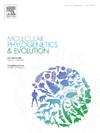解析新西兰特有的杜鹃花(蜂科)多倍体种的网状进化历史。
IF 3.6
1区 生物学
Q2 BIOCHEMISTRY & MOLECULAR BIOLOGY
引用次数: 0
摘要
具有多倍性水平的种属为理解多倍体植物物种间复杂的网状关系的连续全基因组复制提供了模型。本文研究了新西兰特有的Azorella (Apiaceae)植物Schizeilema和Stilbocarpa的17个多倍体分类群(种、亚种或变种)。利用系统基因组学的方法,我们的目标是解决物种关系,确定高水平多倍体(6倍和10倍)的起源,并评估新西兰Azorella物种的生物地理。对Anigosperms353鱼饵采集的Hyb-Seq数据进行系统发育分析,并对利用基因组扫描检索到的nrDNA和质体组序列重建的系统发育进行比较,结果表明,新西兰的物种多样化可能与来自南美洲的多个起源有关,这一起源已被额外的多倍体、杂交或渐入进一步形成。新西兰的两个亚速尔属可能是由南美洲不同的生物地理事件造成的——一个是亚南极岛屿(Stilbocarpa节),另一个是南岛(Schizeilema节)。此外,在Schizeilema剖面内,物种已从南岛(新西兰)分散到澳大利亚、亚南极岛屿和北岛(新西兰)。我们结合质体体和核位点数据的系统基因组分析方法,以及基于snp的网络方法,使我们能够确定新西兰Azorella一些高级多倍体的起源,并揭示了这些谱系中历史和正在进行的多倍体和杂交的更复杂的情况。本文章由计算机程序翻译,如有差异,请以英文原文为准。

Resolving reticulate evolutionary histories of polyploid species of Azorella (Apiaceae) endemic to New Zealand
Genera with species of multiple ploidy levels provide models to understand successive rounds of whole genome duplication leading to intricate reticulate relationships of polyploid plant species. Here, we studied 17 polyploid taxa (species, subspecies, or varieties) in Azorella (Apiaceae) sections Schizeilema and Stilbocarpa that are mostly endemic to New Zealand. Using phylogenomic approaches, our goals were to resolve species relationships, determine the origins of the higher-level polyploids (6x and 10x), and assess the biogeography of the New Zealand Azorella species. Phylogenomic analysis of Anigosperms353 baits-captured Hyb-Seq data, together with comparison of phylogenies reconstructed using genome-skimming retrieved nrDNA and plastome sequences, showed that species diversification within New Zealand may relate to multiple origins from South America, which has been further shaped by additional rounds of polyploidy as well as hybridization or introgression. The two Azorella sections in New Zealand likely resulted from different biogeographic events from South America − one to the subantarctic islands (section Stilbocarpa) and a second to the South Island (section Schizeilema). In addition, within section Schizeilema, species have dispersed from the South Island (New Zealand) to Australia, the subantarctic islands, and the North Island (New Zealand). Our combined approach of phylogenomic analyses of plastome and nuclear locus-based data, together with SNP-based network approaches allowed us to determine the origins of some higher-level polyploids in New Zealand Azorella and revealed a more complex picture of historical and ongoing polyploidy and hybridization within these lineages.
求助全文
通过发布文献求助,成功后即可免费获取论文全文。
去求助
来源期刊
CiteScore
7.50
自引率
7.30%
发文量
249
审稿时长
7.5 months
期刊介绍:
Molecular Phylogenetics and Evolution is dedicated to bringing Darwin''s dream within grasp - to "have fairly true genealogical trees of each great kingdom of Nature." The journal provides a forum for molecular studies that advance our understanding of phylogeny and evolution, further the development of phylogenetically more accurate taxonomic classifications, and ultimately bring a unified classification for all the ramifying lines of life. Phylogeographic studies will be considered for publication if they offer EXCEPTIONAL theoretical or empirical advances.

 求助内容:
求助内容: 应助结果提醒方式:
应助结果提醒方式:


